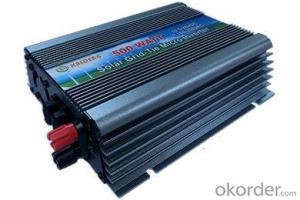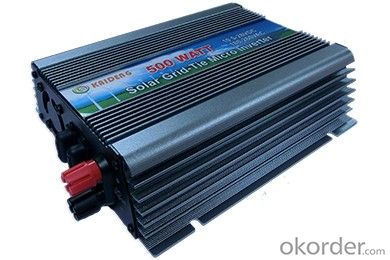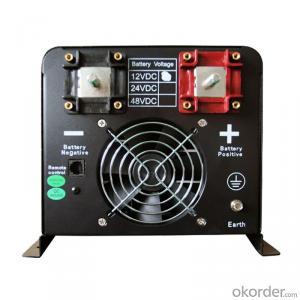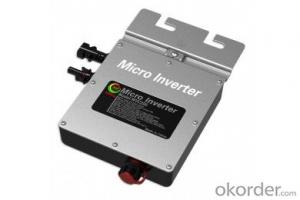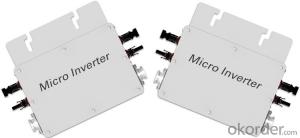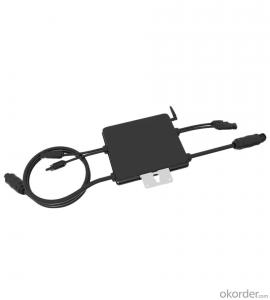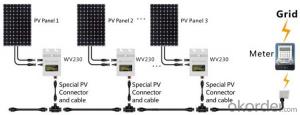24V MPPT Solar Inverter - KD-GTI500W Series Micro Inverter, Hot Sales
- Loading Port:
- China main port
- Payment Terms:
- TT OR LC
- Min Order Qty:
- 1000 pc
- Supply Capability:
- 100000 pc/month
OKorder Service Pledge
OKorder Financial Service
You Might Also Like
Structure
The transition from a centralized to a distributed inverter optimizes energy collection.
The converter module integrated into the solar panels can reduce installation costs.
Soft switch technology to replace hard-switching technology can improve efficiency and reduce heat dissipation.
From cottage industry to mass production, standardized design (hardware and software) to improve reliability and reduce costs.
Using a special capacitor (due to the high failure rate). Design requires a higher voltage to reduce the current, we use a special electrolytic capacitors.
The converter can be connected to the grid to eliminate the need for many battery applications. The high price of batteries, require maintenance, life expectancy is shorter.
Work required micro-inverter power increasingly smaller (only a few hundred watts), which can reduce the internal temperature and improve reliability.
Micro-inverter solar inverter system needs to deal with a lot of a particular power level, in order to increase production, thereby reducing costs.
DC input voltage range:10.5-28VDC
AC output voltage range:80-160VAC/180-260VAC
AC output power :500Wp
AC frequency range:50Hz/60Hz
G.W.:1.8kg
Size:315mm*188mm*85mm
KD-GTI500W Series Using IP67 waterproof streamline design, Can effectively prevent rainwater on the surface erosion, Built-in high-performance Maximum Power Point Tracking(MPPT)Function,Better able to track changes in the solar luminosity and control different output power, Effectively capture and collect sunlight. AC electric power transmission using the reverse transmission technology, Is one of our patented technology, The inverter output power can provide load priority use, Extra electricity to the grid, Efficient use of the inverter to the power emitted, Electricity transmission rate of up to 99%.
Features
Pure Sine Wave Output;
High performance Maximum Power Point Tracking(MPPT);
Power Automatically Locked(APL);
Reverse power transmission;
High-Frequency High Conversion Rate;
Anti-Islanding Protect;
Input /output is fully isolated to protect the electrical safety;
Multiple parallel stacking;
The Leading Patent Technology;
IP65 WaterProof;
Flexible Installation;
Simplify maintenance (user serviceable)
High Efficiency & Best Cost-Effectiveness
Images
Specification
Grid-series models | 300W | 500W | 800W | 1000W |
Recommend use solar panels | 420Wp | 620Wp | 1050Wp | 1250Wp |
DC Maximum Input Power | 400W | 600W | 900W | 1200W |
DC maximum voltage | VpvDC30.2VDC | |||
DC voltage range | Vpv 10.5V~28VDC | |||
Maximum output power factor | 99% | |||
Maximum input current | 20A | 30A | 45A | 65A |
AC output power | 300W | 500W | 800W | 1000W |
AC maximum output power | 300W | 500W | 800W | 1000W |
Anti-voltage protection | Fuse | |||
AC standard voltage range | 90~160VAC/190~262VAC | |||
AC frequency range | 55Hz~63Hz/ 45Hz-53Hz | |||
THDI | <5% | |||
Phase | <1% | |||
Islanding protection | VAC;f AC | |||
Output short circuit protection | Current-limiting | |||
Show | LED | |||
Installation | Wall hanging | |||
Cooling | Fan | |||
Standby Power | <2W | |||
Night Power | <1W | |||
Ambient temperature range | -25 °C~60°C | |||
Humidity | 0~99%(Indoor Type Design) | |||
Waterproof | Indoor Type Design | |||
Electromagnetic Compatibility | EN50081.part1 EN50082.part1 | |||
Power System Disturbance | EN61000-3-2 EN60950-1 | |||
Network test | DIN VDE 1026 | |||
Certificate | CE | |||
FAQ
Can we visit your factory?
Surely, I will arrange the trip basing on your business schedule.
Can you do OEM for us?
Yes, we can.
How do you pack your products?
We have rich experience on how to pack the panels to make sure the safety on shipment when it arrives at the destination.
Can you help us install the module if we cooperate with you?
We haven’t entered into installation sector, but we have the plan in near future.
- Q: Can a solar inverter be used in a mobile or RV application?
- Yes, a solar inverter can be used in a mobile or RV application. A solar inverter converts the direct current (DC) produced by solar panels into alternating current (AC) that can be used to power appliances and devices. This makes it suitable for providing electricity in a mobile or RV setting where solar panels are commonly used to generate power.
- Q: How does a solar inverter handle anti-islanding protection?
- A solar inverter handles anti-islanding protection by constantly monitoring the grid voltage. If the grid goes down or voltage drops below a certain threshold, the inverter automatically disconnects from the grid to prevent feeding power back into the grid during an outage. This ensures the safety of utility workers and prevents damage to the grid.
- Q: What is the role of a galvanic isolation transformer in a solar inverter?
- The role of a galvanic isolation transformer in a solar inverter is to provide electrical isolation between the photovoltaic (PV) array and the inverter's AC output. This isolation is crucial for safety and protection, as it prevents any electrical faults or surges from the PV side from affecting the AC side or the grid. It also ensures that any ground faults or leakage currents are contained within the PV system, minimizing the risk of electric shock and damage to equipment.
- Q: What is the purpose of a solar inverter?
- The purpose of a solar inverter is to convert the direct current (DC) electricity produced by solar panels into alternating current (AC) electricity that can be used to power household appliances and be fed back into the electrical grid.
- Q: Can a solar inverter be used with building-integrated photovoltaic systems?
- Yes, a solar inverter can be used with building-integrated photovoltaic systems. Building-integrated photovoltaic systems are designed to seamlessly integrate solar panels into the building's architecture, and a solar inverter is an essential component that converts the DC power generated by the solar panels into AC power for use in the building's electrical system.
- Q: Can a solar inverter be used in regions with high levels of air pollution?
- Yes, a solar inverter can be used in regions with high levels of air pollution. The performance of the solar inverter may be slightly affected due to the reduced sunlight reaching the solar panels, but it can still convert the available solar energy into usable electricity. Regular maintenance and cleaning of the solar panels may be required to mitigate the impact of air pollution on their efficiency.
- Q: Can a solar inverter be used with different types of grid connection standards?
- Yes, a solar inverter can be used with different types of grid connection standards. Solar inverters are designed to convert the direct current (DC) generated by solar panels into alternating current (AC) that can be fed into the electrical grid. They are manufactured to comply with various grid connection standards and regulations, allowing them to be compatible with different types of grids worldwide. This flexibility enables solar inverters to be used in a wide range of countries and regions with varying grid connection requirements.
- Q: Are there any disadvantages of using a solar inverter?
- Yes, there are a few disadvantages of using a solar inverter. Firstly, solar inverters are sensitive to extreme temperature variations, and their efficiency can be affected in very high or low temperature conditions. Secondly, solar inverters require regular maintenance and occasional replacement, which adds to the overall cost of the system. Additionally, solar inverters produce a small amount of electromagnetic interference (EMI) which can interfere with nearby electronic devices if not properly shielded. Lastly, solar inverters are grid-tied systems, meaning they rely on a stable electrical grid to function. In case of power outages or grid malfunctions, solar inverters may shut down and stop supplying power to the connected devices.
- Q: Can a solar inverter be used with a solar-powered water desalination system?
- Yes, a solar inverter can be used with a solar-powered water desalination system. A solar inverter is responsible for converting the direct current (DC) power generated by solar panels into alternating current (AC) power, which is required to operate most electrical appliances and systems. In the case of a solar-powered water desalination system, the solar inverter can be used to convert the DC power generated by solar panels into AC power to run the various components of the desalination system, such as pumps, motors, and control systems.
- Q: How does a solar inverter handle reactive power injection into the grid?
- A solar inverter handles reactive power injection into the grid by using advanced control algorithms and capacitors. It actively monitors the grid's voltage and frequency and adjusts its output to maintain the required power factor. The inverter can either absorb or inject reactive power into the grid as needed to ensure a stable and balanced power flow.
Send your message to us
24V MPPT Solar Inverter - KD-GTI500W Series Micro Inverter, Hot Sales
- Loading Port:
- China main port
- Payment Terms:
- TT OR LC
- Min Order Qty:
- 1000 pc
- Supply Capability:
- 100000 pc/month
OKorder Service Pledge
OKorder Financial Service
Similar products
Hot products
Hot Searches
Related keywords
